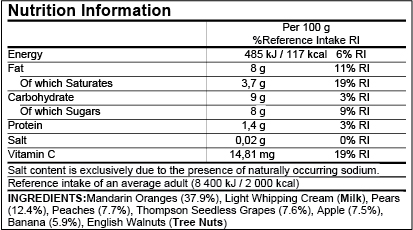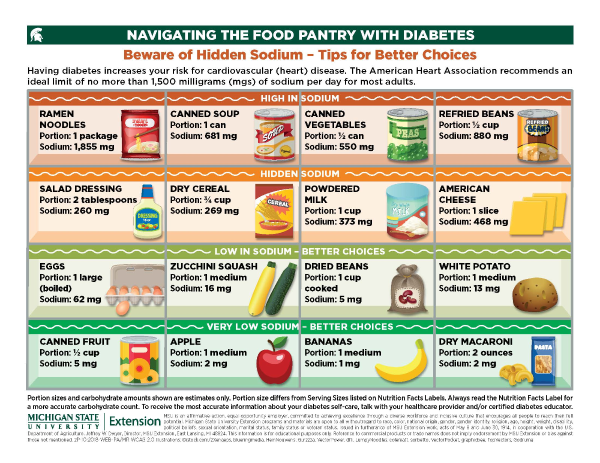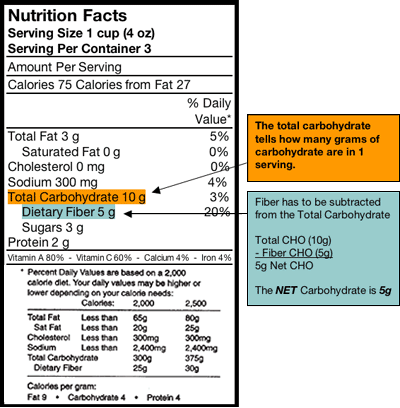43 carbohydrates on nutrition labels
PDF What It Is - Food and Drug Administration The Nutrition Facts label also lists the types of carbohydrate that make up the total carbohydrate in a product. This includes the amount in grams (g) per serving of dietary fiber, total sugars,... What Do Total Carbohydrate And Added Sugar On The Nutrition Label Mean ... Sugars gives you the total amount of carbohydrate, in grams, from naturally occurring sugars like lactose (milk sugar) and fructose (fruit sugar) PLUS any added sugars like high fructose corn syrup, brown and white sugar, cane juice, etc. Added sugars are the sugars and syrups added to foods during processing or preparation.
How to Read Carbohydrates on Food Labels - GlycoLeap When learning how to read carbohydrates on food labels, always remember that 1 serving of carbohydrate is equal to 15 g of carbohydrates. If you want to have a snack, it is recommended to eat no more than 1 to 2 servings of carbohydrates in one sitting. That would be around 15 to 30 g of carbohydrates. Snack = 15 - 30 g of carbohydrate
:max_bytes(150000):strip_icc()/LabelA2-56a5c0f65f9b58b7d0de5351.jpg)
Carbohydrates on nutrition labels
How to Use the Nutrition Facts Label — Diet Doctor This chocolate has 14 grams of carbohydrates per serving. 3. Calculate net carbs per serving Third, check the grams of dietary fiber per serving (circled in green, above). Subtract the fiber (green) from the total carbohydrates (blue) to get the net carbs. This chocolate has 9 grams of net carbs per serving (14g carbs - 5g fiber = 9g net carbs). How to Read Carbohydrates on Nutrition Labels Breakdown of the Label If we break down the carbohydrates section of a nutrition label it usually has 3 parts. Carbohydrates -Sugars -Dietary fibre The top carbohydrates row is the total amount of carbs present. Made up of all the sugars, dietary fibre and starch, which is the remaining amount after the sugar and fibre. PDF Read the Food Label for Carbohydrates Read the Food Label for Carbohydrates Food labels help you choose foods that are lower in calories and in carbohydrates and sweeteners. Here is a food label for a 12-ounce regular soda. The label provides lots of useful information. 1. Serving Size and Number of Servings The serving size is 12 ounces. There's 1 serving in this container. 2.
Carbohydrates on nutrition labels. Interactive Nutrition Facts Label Fact Sheets Nutrition Facts 4 servings per container Serving size 1 1/2 cup (208g) Amount Per Serving 240 Calories % Daily Value* 5% Total Fat 4g 8% Saturated Fat 1.5g Trans Fat 0g 2% Cholesterol... How are Carbohydrates & Dietary Fiber Labelled on Foods? The fibers listed below are the most common sources being added to food and can be declared on the Nutrition Facts label as dietary fiber. FDA approved isolated and synthetic non-digestible carbohydrates Gum Acacia Alginate Apple Fiber Bamboo Fiber Carboxymethylcellulose Corn Hull Fiber Cottonseed Fiber Galactooligosaccharides Reading Food Labels | ADA - American Diabetes Association Put food labels to work The Nutrition Facts labels on foods are really the key to making the best choices. We'll cover the basics so that these labels make shopping easier for you. Get started Understanding Carbs You've heard it all. From carb-free to low-carb, to whole and empty carbs, it's hard to know what it all means. Learn more Nutrition Facts Label: Carbohydrates | Conagra Nutrition Nutrition Facts Label Carbohydrates. Carbohydrates are one of the major calorie-containing nutrients called macronutrients (the other macronutrients are fat and protein). Carbohydrates come in three main forms: starch, sugar, and fiber. When foods contain carbohydrates, they're often a mix of these forms. In packaged foods, the grams and ...
How Do They Calculate Calories on Food Labels? 5 grams of fat (5 x 9 = 45 calories) 22 grams of carbohydrate (22 x 4 = 88 calories) 2 grams of protein (2 x 4 = 8) ...should contain approximately 140 calories. It's important to recognize that 4-9-4 is an average, and not an exact amount. For example, 1 gram of fat in one food may yield 8.34 calories while 1 gram of fat from another food ... How To Read Nutrition Labels For Carbs - Montalvospirit On a nutrition food label, the total carbohydrate includes the sugar. Some Nutrition Facts labels may also list sugar alcohols under total carbohydrate. Should I count carbs or net carbs? The exact number of grams (g) of carbohydrates will be different for everyone, but is generally around 20 to 50 g per day. Many people on a keto diet count ... What Is the Difference Between Sugar & Carbs on Food Labels? Each gram of carbohydrate and protein provides 4 calories, while a gram of fat provides 9 calories. Carbohydrates are found in a wide variety of foods, such as grain products, including bread, pasta, breakfast cereals, oatmeal, flours, crackers, starchy vegetables like potatoes and corn, legumes, milk, yogurt, fruits, juices, sugar and desserts. How to Read Food Labels | Your Low Carb Hub The below label shows there are 4.3g of carbs in a 15ml serving size which is equivalent to one tablespoon. 3.4g of this is sugar. There is 22.7g of sugar in 100ml, that's 5.6 teaspoons of sugar. The World Health Organisation (WHO) recommends no more than 5-10 teaspoons of added sugar in an entire day.
Carb Counting #2: Nutrition Labels Total Carbohydrate reflects all sugars, including sugar, starch, fiber, and sugar alcohol. The "Sugar" listed under Total Carbohydrate is very misleading; all carbohydrate (sugar and starch) is included as part of "Total Carbohydrate." Be careful, it's easy to confuse the weight in grams of the food item with grams of Total Carbohydrate. Reading food labels: Tips if you have diabetes - Mayo Clinic Less than 5 grams of carbohydrates a serving Do the math Pay attention to serving sizes. The serving sizes listed on food labels may be different from the serving sizes in your meal plan. If you eat twice the serving size listed on the label, you also double the calories, fat, carbohydrates, protein, sodium and other ingredients. How to Understand and Use the Nutrition Facts Label | FDA Dietary fiber, vitamin D, calcium, iron ad potassium are nutrients on the label that Americans generally do not get the recommended amount of. They are identified as nutrients to get more of.... The New Nutrition Facts Label | FDA The U.S. Food and Drug Administration (FDA) has updated the Nutrition Facts label on packaged foods and drinks. FDA is requiring changes to the Nutrition Facts label based on updated scientific ...
Low Carb Guide to Understanding Nutrition Labels - Virta Health Total Carbohydrate The carbohydrate count is given as total grams, and then broken down into carbs from fiber and sugar. Focus on total carbohydrate. Sugar should be zero as often as possible (1-2g at most). Fiber is a carb and should be included in your total for the day (initially 30g or less). Again, pay attention to the serving size.
Food Labels: Carbohydrates | Home & Garden Information Center According to nutrition experts, carbohydrates should provide 45-65% of your total daily calories. That means carbohydrates should supply 900 calories or more in a 2,000-calorie-a-day diet. Facts on Food Labels Food labels contain clues to a food's carbohydrate content, including the amount per serving.
Get Smart On Carbs | ADA - American Diabetes Association As you'll see on the nutrition labels for the food you buy, the term "total carbohydrate" refers to all three of these types. The goal is to choose carbs that are nutrient-dense, which means they are rich in fiber, vitamins and minerals, and low in added sugars, sodium and unhealthy fats. When choosing carbohydrate foods:
How To Read Nutrition Labels (Like a Pro) - Ditch The Carbs Carbohydrates will be on the nutrition label are often broken down into carbohydrates, sugars, starch, and fiber. However, each brand may display its nutritional contents differently. And depending on which country you are in they will either show NET or TOTAL carbs and sometimes it isn't clear which they are referring to.
PDF Using Nutrition Labels: Carbohydrate - Western Carolina University Using Nutrition Labels: Carbohydrate Serving Size Look at the serving size. All the information on the label is based on this portion. Servings Per Container The number of servings contained in the package. Guidelines for Carbohydrate Look at the total grams of carbohydrate in the serving size. 1 carbohydrate choice = 15 grams of carbohydrate.
How To Figure Out The Carbs On Nutrition Labels If more than one type of sugar alcohol is listed, there must be a line for sugar alcohol grams on the nutrition label. Other Carbohydrates shows the number of digestible complex carbohydrates not considered a sugar (natural or added) and includes additives like stabilizers and starchy thickening agents. They don't make it easy, do they? Save
Food Labels | CDC If you eat the whole thing, you are eating 8 times the amount of calories, carbs, fat, etc., shown on the label. Total Carbohydrate shows you types of carbs in the food, including sugar and fiber. Choose foods with more fiber, vitamins, and minerals. Choose foods with lower calories, saturated fat, sodium, and added sugars. Avoid trans fat.
What "Net Carbs" On Food Labels Actually Means - Lifehacker A myriad of low-carb products are marketed as having "zero net carbs", but a closer look at the nutrition label reveals most of the "cancelled" carbs to be from dietary fiber or sugar ...
Food Labels and Counting Carbs - dummies Total Carbohydrate is listed in grams. Because %Daily Value is written in bold and off to the right side of the label, and lined up neatly with the actual amount, it is easy to allow your eye to zero in on the %Daily Value rather than the actual amount in grams.
Learning To Read Labels :: Diabetes Education Online The grams of sugar listed include both natural sugars, from fruit or milk, and added sugars. On a nutrition food label, the total carbohydrate includes the sugar. Some Nutrition Facts labels may also list sugar alcohols under total carbohydrate. Sugar alcohols may be found in products that are labeled "sugar-free" or "no sugar added."
Reading labels | Diabetes UK These days, food labels should have all the key nutritional information you need to count the carbs in your meal. This video will help you to understand food labels and learn about the carbohydrate levels in everyday meals, with tips and advice from Jess along the way. YouTube. Diabetes UK. 51.8K subscribers.
PDF Read the Food Label for Carbohydrates Read the Food Label for Carbohydrates Food labels help you choose foods that are lower in calories and in carbohydrates and sweeteners. Here is a food label for a 12-ounce regular soda. The label provides lots of useful information. 1. Serving Size and Number of Servings The serving size is 12 ounces. There's 1 serving in this container. 2.
How to Read Carbohydrates on Nutrition Labels Breakdown of the Label If we break down the carbohydrates section of a nutrition label it usually has 3 parts. Carbohydrates -Sugars -Dietary fibre The top carbohydrates row is the total amount of carbs present. Made up of all the sugars, dietary fibre and starch, which is the remaining amount after the sugar and fibre.
How to Use the Nutrition Facts Label — Diet Doctor This chocolate has 14 grams of carbohydrates per serving. 3. Calculate net carbs per serving Third, check the grams of dietary fiber per serving (circled in green, above). Subtract the fiber (green) from the total carbohydrates (blue) to get the net carbs. This chocolate has 9 grams of net carbs per serving (14g carbs - 5g fiber = 9g net carbs).
:max_bytes(150000):strip_icc()/Untitled-design-5753677f5f9b5892e8d7d171.jpg)








/Untitled-design-1--5755c3703df78c9b46903dab.jpg)



Post a Comment for "43 carbohydrates on nutrition labels"